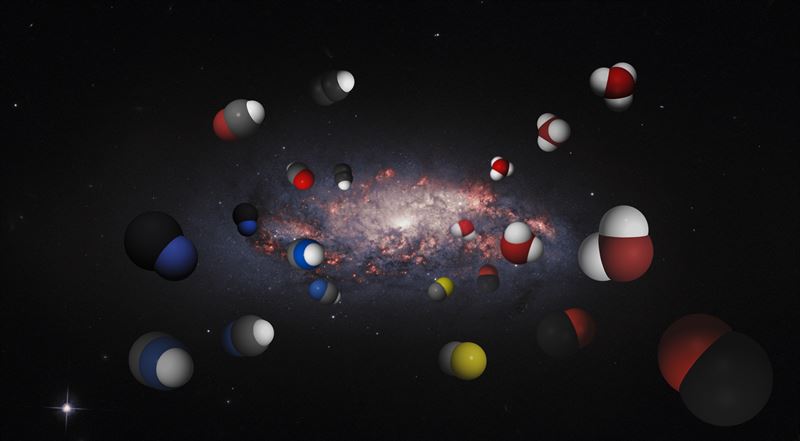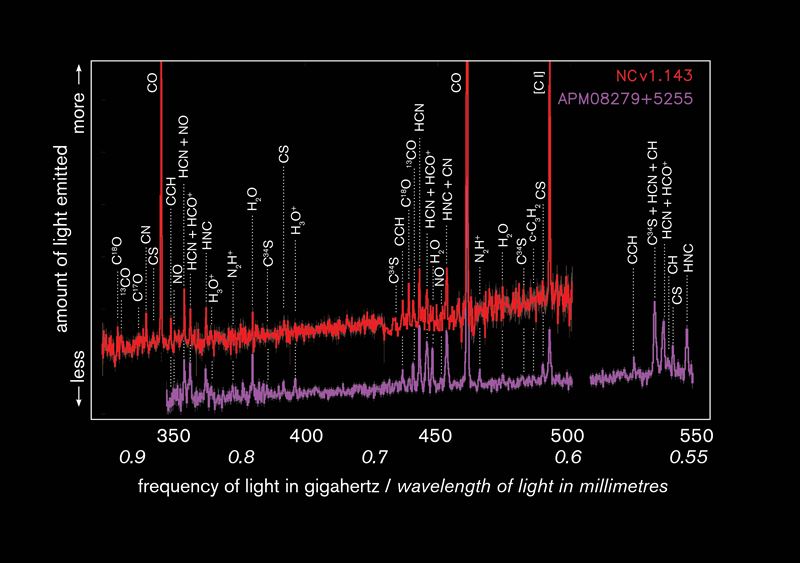| Dec 14, 2023 |
Unexpected chemistry reveals cosmic star factories' secrets
|
|
(Nanowerk News) Two galaxies in the early universe, which contain extremely productive star factories, have been studied by a team of scientists led by Chalmers University of Technology in Sweden. Using powerful telescopes to split the galaxies’ light into individual colours, the scientists were amazed to discover light from many different molecules – more than ever before at such distances. Studies like this could revolutionise our understanding of the lives of the most active galaxies when the universe was young, the researchers believe.
|
|
When the universe was young, galaxies were very different from today’s stately spirals, which are full of gently-shining suns and colourful gas clouds. New stars were being born, at rates hundreds of times faster than in today’s universe. Most of this however, was hidden behind thick layers of dust, making it a challenge for scientists to discover these star factories’ secrets – until now. By studying the most distant galaxies visible with powerful telescopes, astronomers can get glimpses of how these factories managed to create so many stars.
|
 |
| Light from many different molecules reveals the secrets of distant star factories. The illustration shows representations of the molecules found in the distant galaxy NCv1.143, superimposed on an image of a similar galaxy in the nearby universe – NGC 572 – taken in visible light by the Hubble telescope. (Image: ESA/Hubble, NASA, L. Ho; Jmol (molecules); R. Cumming (montage))
|
|
In a new study, published in the journal Astronomy & Astrophysics ("SUNRISE: The rich molecular inventory of high-redshift dusty galaxies revealed by broadband spectral line surveys"), a team of scientists led by Chalmers astronomer Chentao Yang, used the telescopes of NOEMA (NOrthern Extended Millimetre Array) in France to find out more about how these early star factories managed to create so many stars. Yang and his colleagues measured light from two luminous galaxies in the early universe – one of them classified as a quasar, and both with high rates of star formation.
|
|
“We knew these galaxies were prodigious star factories, perhaps amongst the biggest the universe has ever seen. To be able to find out how they work, we measured their light at wavelengths around one millimetre, hoping to collect new clues,” says Chentao Yang.
|
Dramatic chemistry in the distant galaxies excites the astronomers
|
|
The measurements proved to be successful beyond the scientists’ expectations. In the light they recorded from both galaxies, they identified traces of many different kinds of molecules. From deep within these galaxies, light is emitted in many different wavelengths from the clouds of gas and dust where new stars are born.
|
|
“It’s an amazing explosion of colour, in shades that the human eye can’t see. But by combining our observations with our knowledge of physics and chemistry, we can understand what the colours mean, and see what differences there are between different galaxies,” explains Sergio Martín, astronomer at ESO and Joint ALMA Observatory, Chile, and member of the research team.
|
|
By analysing each galaxy’s spectrum – the individual colours of their light – the scientists were able to identify 13 molecules, several of which have never been seen before in such distant galaxies. Each molecule gives different clues about the temperature, pressure, and density in the space between the stars, and about how starlight, radiation and matter interact – providing key new information on the physical and chemical conditions in these galaxies.
|
|
“Interpreting the signals is a challenge. We are seeing part of the electromagnetic spectrum that is hard to observe in nearby galaxies. But thanks to the expansion of the universe, the light from distant galaxies like these is shifted to longer wavelengths that we can see with radio telescopes observing in the sub-millimetre”, says Chentao Yang.
|
 |
| Light from two distant galaxies showing signs of many different molecules. The sharp peaks in these graphs, known as spectral lines, tell astronomers about the gas clouds that emit the light. The horizontal axis shows both wavelength and frequency of the light; the vertical axis shows relative brightness. The top spectrum has been shifted upwards for clarity. In red, the graph shows the galaxy NCv1.143 and in purple, APM 08279+5255. (Image: Chentao Yang et al.)
|
More like a neon-lit city than a night under the stars
|
|
The two galaxies studied by the team are so far away that their light takes almost 13 billion years to reach us.
|
|
“Looking at these galaxies is less like a night under the stars and more like seeing a city lit with neon lights”, says Susanne Aalto, Chalmers astronomer and team member.
|
|
Astronomers are used to taking pictures of our galaxy’s star factories, like the Orion Nebula and the Carina Nebula, she explains.
|
|
“In these two distant galaxies, we are instead seeing star factories that are bigger, brighter, full of dust, and different in many ways. The Orion and Carina nebulae are lit up thanks to ultraviolet light from hot, newborn stars. In these two distant galaxies, ultraviolet light can’t get past the layers of dust. Much of the illumination is instead thanks to cosmic rays – high energy particles that can be created by exploding stars, or close to a supermassive black hole”, says Susanne Aalto.
|
The galaxies in the early universe can now tell their stories
|
|
While galaxies like these two are rare, the scientists have plans to study more of them, using both NOEMA and its even bigger sister telescope, ALMA (the Atacama Large Millimetre/Submillimetre Array) in Chile. Both telescopes are sensitive to light with wavelengths of around one millimetre.
|
|
“Our results show how NOEMA, with its broadband receivers and powerful correlator computer, has opened up new opportunities for studying extreme galaxies like these in the northern sky. From the southern hemisphere, ALMA’s planned wideband sensitivity upgrades will offer even more exciting prospects. The most remarkable galaxies in the early universe are finally able to tell their stories through their molecules”, says Pierre Cox, astronomer at CNRS and Sorbonne Université, France.
|


